Monochelic Versus Telechelic Poly(Methyl Methacrylate) as a Matrix for Photoluminescent Nanocomposites with Quantum Dots
Abstract
:1. Introduction
2. Results and Discussion
2.1. Formation of PMMA Mono- and Telechelic Complexes with CdSe and CdSe/ZnS Quantum Dots
2.2. Morphology and Molecular Structure of Complexes of QDs with PMMA
2.3. Optical Properties of Nanocomposites
3. Materials and Methods
3.1. Materials
3.2. Quantum Dots Synthesis
3.3. Polymer Synthesis and Modification
3.4. Preparation of PMMA—QDs Nanocomposite Films and Sols
3.5. Instrumentation
4. Conclusions
Author Contributions
Funding
Data Availability Statement
Conflicts of Interest
Sample Availability
References
- Zeng, R.; Sun, Z.; Cao, S.; Shen, R.; Liu, Z.; Long, J.; Zheng, J.; Shen, Y.; Lin, X. A facile route to aqueous Ag:ZnCdS and Ag:ZnCdSeS quantum dots: Pure emission color tunable over entire visible spectrum. J. Alloys Comps. 2015, 632, 1–9. [Google Scholar] [CrossRef]
- Barak, Y.; Meir, I.; Shapiro, A.; Jang, Y.; Lifshitz, E. Fundamental properties in colloidal quantum dots. Adv. Mater. 2018, 30, 1801442. [Google Scholar] [CrossRef]
- Brichkin, S.B.; Razumov, F.M. Colloidal quantum dots: Synthesis, properties and applications. Russ. Chem. Rev. 2016, 85, 1297. [Google Scholar] [CrossRef]
- Jasim, K.E. Quantum dots solar cells. In Solar Cells—New Approaches and Reviews; Kosyachenko, L.A., Ed.; IntechOpen: London, UK, 2015; pp. 303–331. [Google Scholar]
- Michalet, X.; Pinaud, F.F.; Bentolila, L.A.; Tsay, J.M.; Doose, S.; Li, J.J.; Sundaresan, G.; Wu, A.M.; Gambhir, S.S.; Weiss, S. Quantum dots for live cells, in vivo imaging, and diagnostics. Science 2005, 307, 538–544. [Google Scholar] [CrossRef] [Green Version]
- Mukai, K. Semiconductor quantum dots for future optical applications. J. Nanosci. Nanotechnol. 2014, 14, 2148–2156. [Google Scholar] [CrossRef]
- Shandryuk, G.A.; Rebrov, A.V.; Vasiliev, R.B.; Dorofeev, S.G.; Merekalov, A.S.; Gaskov, A.M.; Talroze, R.V. Stabilization of cadmium selenide quantum dots in a liquid crystal polymer. Polym. Sci. 2005, 47, 266–268. [Google Scholar]
- Klimov, V.I.; Mikhailovsky, A.A.; Xu, S.; Malko, A.; Hollingsworth, J.A.; Leatherdale, C.A.; Eisler, H.-J.; Bawendi, M.G. Optical gain and stimulated emission in nanocrystal quantum dots. Science 2000, 290, 314–317. [Google Scholar] [CrossRef] [Green Version]
- Gordillo, H.; Suárez, I.; Abargues, R.; Rodríguez-Cantó, P.; Albert, S.; Martínez-Pastor, J.P. Polymer/QDs nanocomposites for waveguiding applications. J. Nanomat. 2012, 2012, 960201. [Google Scholar] [CrossRef]
- Murray, C.B.; Norris, D.J.; Bawendi, M.G. Synthesis and characterization of nearly monodisperse CdE (E = sulfur, selenium, tellurium) semiconductor nanocrystallites. J. Am. Chem. Soc. 1993, 115, 8706–8715. [Google Scholar] [CrossRef]
- Pang, L.; Shen, Y.; Tetz, K.; Fainman, Y. PMMA quantum dots composites fabricated via use of pre-polymerization. Opt. Express 2005, 13, 44–49. [Google Scholar] [CrossRef]
- Guo, Y.; Moffitt, M.G. “Smart” self-assembled quantum dots regulate and stabilize structure in phase-separated polymer blends. Chem. Mater. 2007, 19, 6581–6587. [Google Scholar] [CrossRef]
- Mohan, S.; Soman, T.; Oluwafemi, S.O.; George, S.C.; Miska, P.; Rouxel, D.; Kalarikkal, N.; Thomas, S. Green synthesis of CdSe/ZnS core-shell quantum dot nanophospors and its poly(methyl methacrylate) composite thin film in the visible spectral range. MRS Proc. 2015, 1748, 26–31. [Google Scholar] [CrossRef]
- Valais, I.; Michail, C.; Fountzoula, C.; Tseles, D.; Yannakopoulos, P.; Nikolopoulos, D.; Bakas, A.; Fountos, G.; Saatsakis, G.; Sianoudis, I.; et al. On the response of alloyed ZnCdSeS Quantum Dot films. Results Phys. 2017, 7, 1734–1736. [Google Scholar] [CrossRef]
- Sun, D.; Sue, H.J. Tunable ultraviolet emission of ZnO quantum dots in transparent poly(methyl methacrylate). Appl. Phys. Lett. 2009, 94, 253106. [Google Scholar] [CrossRef]
- Hpone Myin, K.; Brown, J.R.; Shim, A.R.; Wyslouzil, B.E. Encapsulation of nanoparticles during polymer micelle formation: A dissipative particle dynamics study. J. Phys. Chem. B 2016, 120, 11582–11594. [Google Scholar] [CrossRef] [PubMed]
- Gao, Y.; Reischmann, S.; Hanke, T.; Bratschitsch, R.; Leitenstorfer, A.; Mecking, S. Positioning of quantum dots into prestructured arrays by polymer encapsulation. Polym. Mater. Sci. Eng. 2008, 98, 234–235. [Google Scholar]
- Yuwen, L. One-pot encapsulation of luminescent quantum dots synthesized in aqueous solution by amphiphilic polymers. Small 2011, 7, 1456–1463. [Google Scholar] [CrossRef]
- Wei, S.; Sampathi, J.; Guo, Z.; Anumandla, N.; Rutman, D.; Kucknoor, A.; James, L.; Wang, A. Nanoporous poly(methyl methacrylate)-quantum dots nanocomposite fibers toward biomedical applications. Polymer 2011, 52, 5817–5829. [Google Scholar] [CrossRef]
- Kamps, A.C.; Sanchez-Gaytan, B.L.; Hickey, R.J.; Clarke, N.; Fryd, M.; Park, S.-J. Nanoparticle-directed self-assembly of amphiphilic block copolymers. Langmuir 2010, 26, 14345–14350. [Google Scholar] [CrossRef]
- Zhang, H.; Liu, Y.; Yaj, D.; Yang, B. Hybridization of inorganic nanoparticles and polymers to create regular and reversible self-assembly architectures. Chem. Soc. Rev. 2012, 41, 6066–6088. [Google Scholar] [CrossRef]
- Boles, M.A.; Ling, D.; Hyeon, T.; Talapin, D.V. The surface science of nanocrystals. Nat. Mater. 2016, 15, 141–153. [Google Scholar] [CrossRef]
- Wang, C.W.; Moffitt, M.G. Use of block copolymer-stabilized cadmium sulfide quantum dots as novel traces for laser scanning confocal fluorescence imaging of blend morphology in polystyrene/poly(methyl methacrylate) films. Langmuir 2005, 21, 2465–2473. [Google Scholar] [CrossRef] [PubMed]
- Bugakov, M.; Boiko, N.; Samokhvalov, P.; Zhu, X.; Möller, M.; Shibaev, V. Liquid crystalline block copolymers as adaptive agents for compatibility between CdSe/ZnS quantum dots and low-molecular-weight liquid crystals. J. Mater. Chem. C 2019, 7, 4326–4331. [Google Scholar] [CrossRef]
- Ehlert, S.; Taheri, S.M.; Pirner, D.; Drechsler, M.; Schmidt, H.-W.; Förster, S. Polymer ligand exchange to control stabilization and compatibilization of nanocrystals. ASC Nano 2014, 8, 6114–6122. [Google Scholar] [CrossRef]
- Ehlert, S.; Stegelmeier, C.; Pirner, D.; Förster, S. A general route to optically transparent highly filled polymer nanocomposites. Macromolecules 2015, 48, 5323–5327. [Google Scholar] [CrossRef]
- Chiefari, J.; Chong, Y.K.B.; Ercole, F.; Krstina, J.; Jeffery, J.; Le, T.P.R.; Mayadunne, R.T.A.; Meijs, G.F.; Moad, C.L.; Moad, G.; et al. Living free-radical polymerization by reversible addition–fragmentation chain transfer: RAFT process. Macromolecules 1998, 31, 5559–5562. [Google Scholar] [CrossRef]
- Barner-Kowollik, C. (Ed.) Handbook of RAFT Polymerization; Wiley: Weinheim, Germany, 2008. [Google Scholar]
- Moad, G.; Rizzardo, E.; Thang, S.H. Radical addition–fragmentation chemistry in polymer synthesis. Polymer 2008, 49, 1079–1131. [Google Scholar] [CrossRef] [Green Version]
- Moad, G.; Rizzardo, E.; Thang, S.H. Living radical polymerization by the RAFT process—A second update. Aust. J. Chem. 2009, 65, 985–1076. [Google Scholar] [CrossRef]
- Moad, G.; Rizzardo, E.; Thang, S.H. Living radical polymerization by the RAFT process—A third update. Aust. J. Chem. 2012, 62, 1402–1472. [Google Scholar] [CrossRef]
- Moad, G.; Rizzardo, E.; Thang, S.H. End-functional polymers, thiocarbonylthio group removal/transformation and reversible addition–fragmentation–chain transfer (RAFT) polymerization. Polym. Int. 2011, 60, 9–25. [Google Scholar] [CrossRef]
- Pourjavadi, A.; Rahemipoor, S.; Kohestanian, M. Synthesis and characterization of multi stimuli-responsive block copolymer-silica hybrid nanocomposite with core-shell structure via RAFT polymerization. Compos. Sci. Technol. 2020, 188, 107951. [Google Scholar] [CrossRef]
- Moura, I.; de Sá, A.; Abreu, A.S.; Oliveira, M.; Machado, A.V. Hybrid nanocomposites of a fluorescent block copolymer and quantum dots: An efficient way for energy transfer. Dyes Pigment. 2017, 141, 29–37. [Google Scholar] [CrossRef]
- Nguyen, T.D.; Vu-Quang, H.; Vo, T.S.; Nguyen, D.C.; Vo, D.N.; Nguyen, D.H.; Lim, K.T.; Tran, D.L.; Bach, L.G. Chemical Synthesis and Characterization of Poly(poly(ethylene glycol) methacrylate)-Grafted CdTe Nanocrystals via RAFT Polymerization for Covalent Immobilization of Adenosine. Polymers 2019, 11, 77. [Google Scholar] [CrossRef] [PubMed] [Green Version]
- Zhu, Y.; Egap, E. PET-RAFT polymerization catalyzed by cadmium selenide quantum dots (QDs): Grafting-from QDs photocatalysts to make polymer nanocomposites. Polym. Chem. 2020, 11, 1018–1024. [Google Scholar] [CrossRef]
- Yoon, C.; Yang, K.P.; Kim, J.; Shin, K.; Lee, K. Fabrication of highly transparent and luminescent quantum dot/polymer nanocomposite for light emitting diode using amphiphilic polymer-modified quantum dots. Chem. Eng. J. 2020, 382, 122792. [Google Scholar] [CrossRef]
- Ezhov, A.A.; Derikov, Y.I.; Chernikova, E.V.; Abramchuk, S.S.; Shandryuk, G.A.; Merekalov, A.S.; Panov, V.I.; Talroze, R.V. Monochelic copolymer as a matrix for cholesteric composites with gold nanoparticles. Polymer 2015, 77, 113–121. [Google Scholar] [CrossRef]
- Ezhov, A.A.; Derikov, Y.I.; Shandryuk, G.A.; Chernikova, E.V.; Abramchyuk, S.S.; Merekalov, A.S.; Bondarenko, G.N.; Talroze, R.V. Composites based on liquid-crystalline polymers with terminal functional groups and inorganic nanoparticles. Polym. Sci. C 2016, 58, 102–117. [Google Scholar] [CrossRef]
- Karpov, O.N.; Shandryuk, G.A.; Derikov, Y.V.; Merekalov, A.S.; Otmakhova, O.A.; Shatalova, A.M.; Talroze, R.V. Blend Composites Based on Polystyrene–CdSe Quantum Dots and Polystyrene–Gold Nanoparticles Hybrid Systems. Polym. Sci. B 2018, 6, 370–379. [Google Scholar] [CrossRef]
- Ko, J.; Jeong, B.G.; Chang, J.H.; Joung, J.F.; Yoon, S.; Lee, D.C.; Park, S.; Huh, J.; Yang, H.; Bae, W.K.; et al. Chemically resistant and thermally stable quantum dots prepared by shell encapsulation with cross-linkable block copolymer ligands. NPG Asia Mater. 2020, 12, 19. [Google Scholar] [CrossRef]
- Litmanovich, E.A.; Bekanova, M.Z.; Shandryuk, G.A.; Chernikova, E.V.; Talroze, R.V. Macromolecules-ghosts in dynamic light scattering analysis: An approach to study interaction between CdSe quantum dots and RAFT-based poly(methyl methacrylate). Polymer 2018, 142, 1–10. [Google Scholar] [CrossRef]
- Karpov, O.N.; Merekalov, A.S.; Ezhov, A.A.; Litmanovich, E.A.; Shandryuk, G.A.; Talroze, R.V. Structure and morphology of polystyrene-QDs composites in sols and solid films. J. Mol. Struct. 2020, 1202, 127280. [Google Scholar] [CrossRef]
- Ezhov, A.A.; Karpov, O.N.; Merekalov, A.S.; Abramchuk, S.S.; Bondarenko, G.N.; Talroze, R.V. Quantum dots—Polymer composites and the influence of gold nanoparticles on photoluminescence of polymer composite films. J. Lumin. 2020, 220, 116992. [Google Scholar] [CrossRef]
- Yoon, C.; Kim, H.; Kim, M.; Shin, K.; Kim, Y.; Lee, K. Fabrication of highly luminescent and concentrated quantum dot/poly(methyl methacrylate) nanocomposites by matrix-free methods. Nanotechnology 2017, 28, 405203. [Google Scholar] [CrossRef] [Green Version]
- Willcock, H.; O’Reilly, R.K. End group removal and modification of RAFT polymers. Polym. Chem. 2010, 1, 149–157. [Google Scholar] [CrossRef]
- Wang, Z.; Wang, S.; Liu, Z.; Zhou, B.; Wen, Y.; Lu, Z.; Chen, R.; Shan, B. Bonding behavior and passivation mechanism of organic ligands (-SH, -NH2, -COOH) on ZnS (11-10) surface from first-principles calculations. Appl. Surf. Sci. 2021, 545, 148970. [Google Scholar] [CrossRef]
- Shandryuk, G.A.; Matukhina, E.V.; Vasil’ev, R.B.; Rebrov, A.; Bondarenko, G.N.; Merekalov, A.S.; Gas’kov, A.M.; Talroze, R.V. Effect of H-bonded liquid crystal polymers on CdSe quantum dot alignment within nanocomposite. Macromolecules 2008, 41, 2178–2185. [Google Scholar] [CrossRef]
- Zhelev, Z.; Jose, R.; Nagase, T.; Ohba, H.; Bakalova, R.; Ishikawa, M.; Baba, Y. Enhancement of the photoluminescence of CdSe quantum dots during long-term UV-irradiation: Privilege or fault in life science research? J. Photochem. Photobiol. B 2004, 75, 99–105. [Google Scholar] [CrossRef] [PubMed]
- Korsunska, N.E.; Dybiec, M.; Zhukov, L.; Ostapenkom, S.; Zhukov, T. Reversible and non-reversible photo-enhanced luminescence in CdSe/ZnS quantum dots. Semicond. Sci. Technol. 2005, 20, 876–882. [Google Scholar] [CrossRef]
- Triana, M.A.; Jaramillo-Quintero, O.A.; Camargo, R.J.; Rincon, M.E. Direct assembly of thioacid capped quantum dots in solid-state hybrid photovoltaics, effect of QDs size and thermal annealing. RSC Adv. 2017, 7, 13543. [Google Scholar] [CrossRef] [Green Version]
- Pandey, C.S.; Wang, C.J.; Mountziaris, T.J.; Maroudas, D. Thermodynamic instability of ZnSe/ZnS core/shell quantum dots. J. Appl. Phys. 2012, 111, 113526. [Google Scholar] [CrossRef]
- Vasiliev, R.B.; Dorofeev, S.G.; Dirin, D.N.; Belov, D.A.; Kuznetsova, T.A. Crystallite size effect on the conductivity on the ultradisperse ceramics of SnO2 and In2O3. Mendeleev Commun. 2004, 14, 167–169. [Google Scholar] [CrossRef]
- Bae, W.K.; Char, K.; Hur, H.; Lee, S. Single-Step Synthesis of Quantum Dots with Chemical Composition Gradients. Chem. Mater. 2008, 20, 531–539. [Google Scholar] [CrossRef]
- Bekanova, M.Z.; Neumolotov, N.K.; Jablanovic, A.D.; Plutalova, A.V.; Chernikova, E.V.; Kudryavtsev, Y.V. Thermal stability of RAFT-based poly(methyl methacrylate): A kinetic study of the dithiobenzoate and trithiocarbonate end-group effect. Polym. Degrad. Stab. 2019, 164, 18–27. [Google Scholar] [CrossRef]
- Bugakov, M.; Abdullaeva, S.; Samokhvalov, P.; Abramchuk, S.; Boiko, N. Hybrid fluorescent liquid crystalline composites: Directed assembly of quantum dots in liquid crystalline block copolymer matrices. RSC Adv. 2020, 10, 15264–15273. [Google Scholar] [CrossRef]


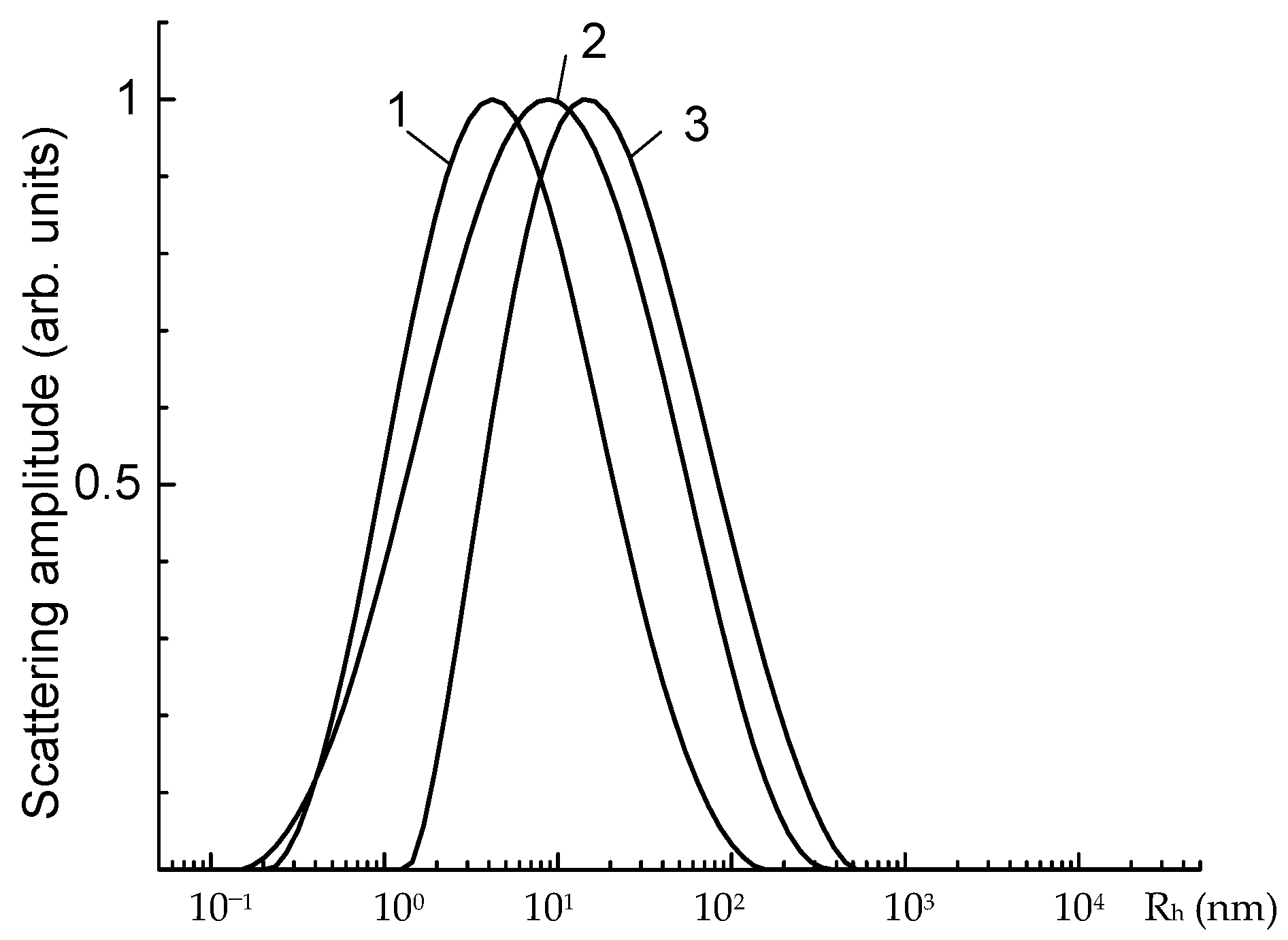
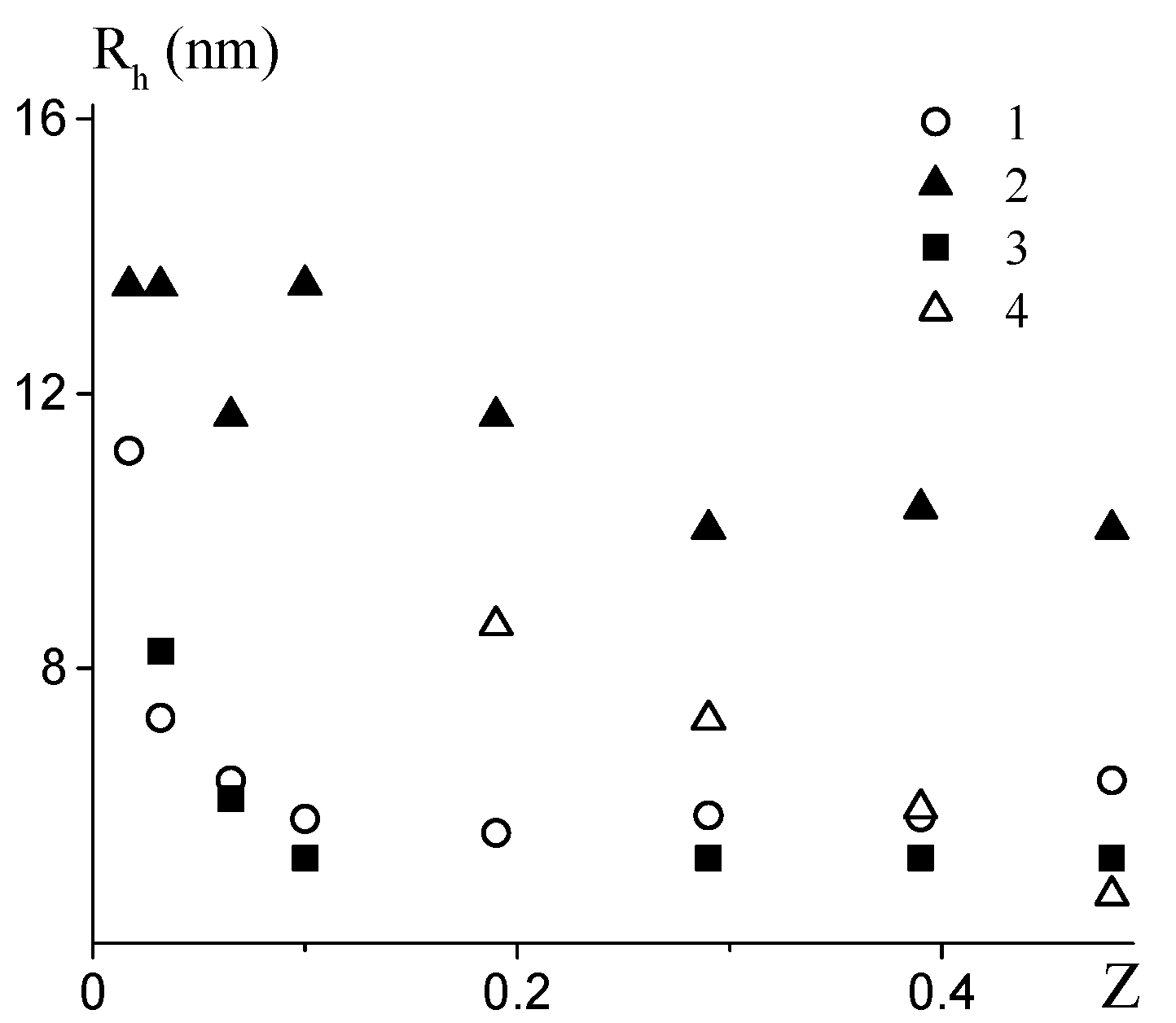
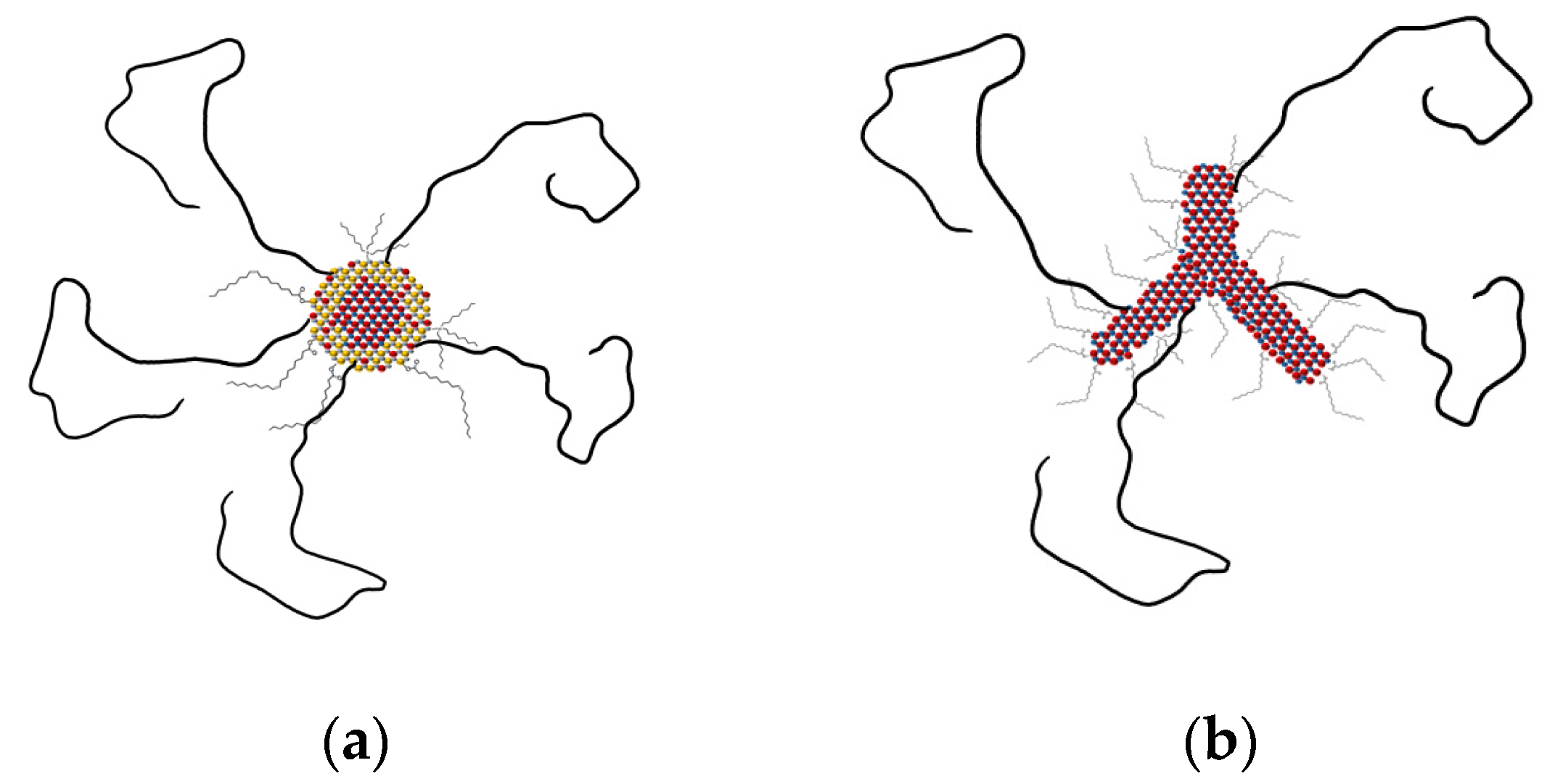

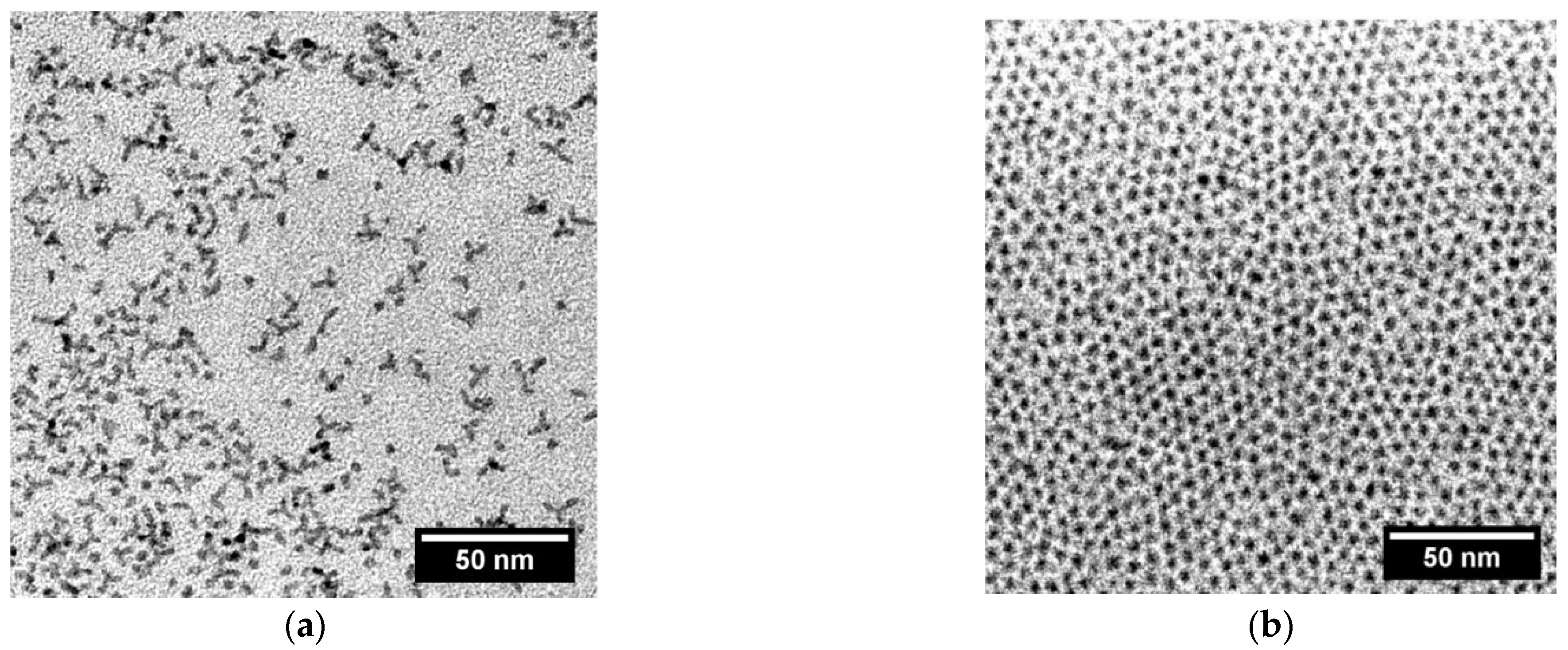
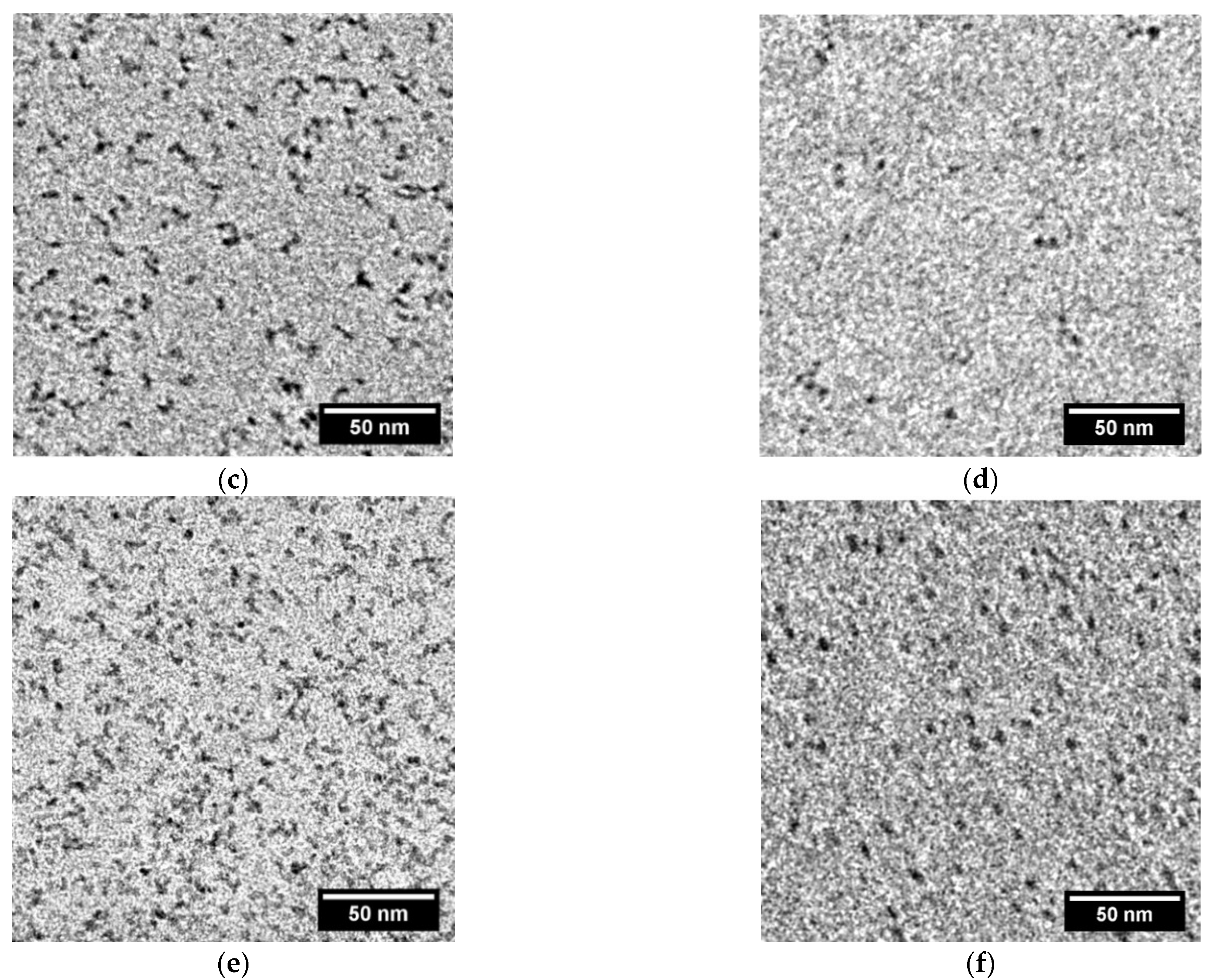
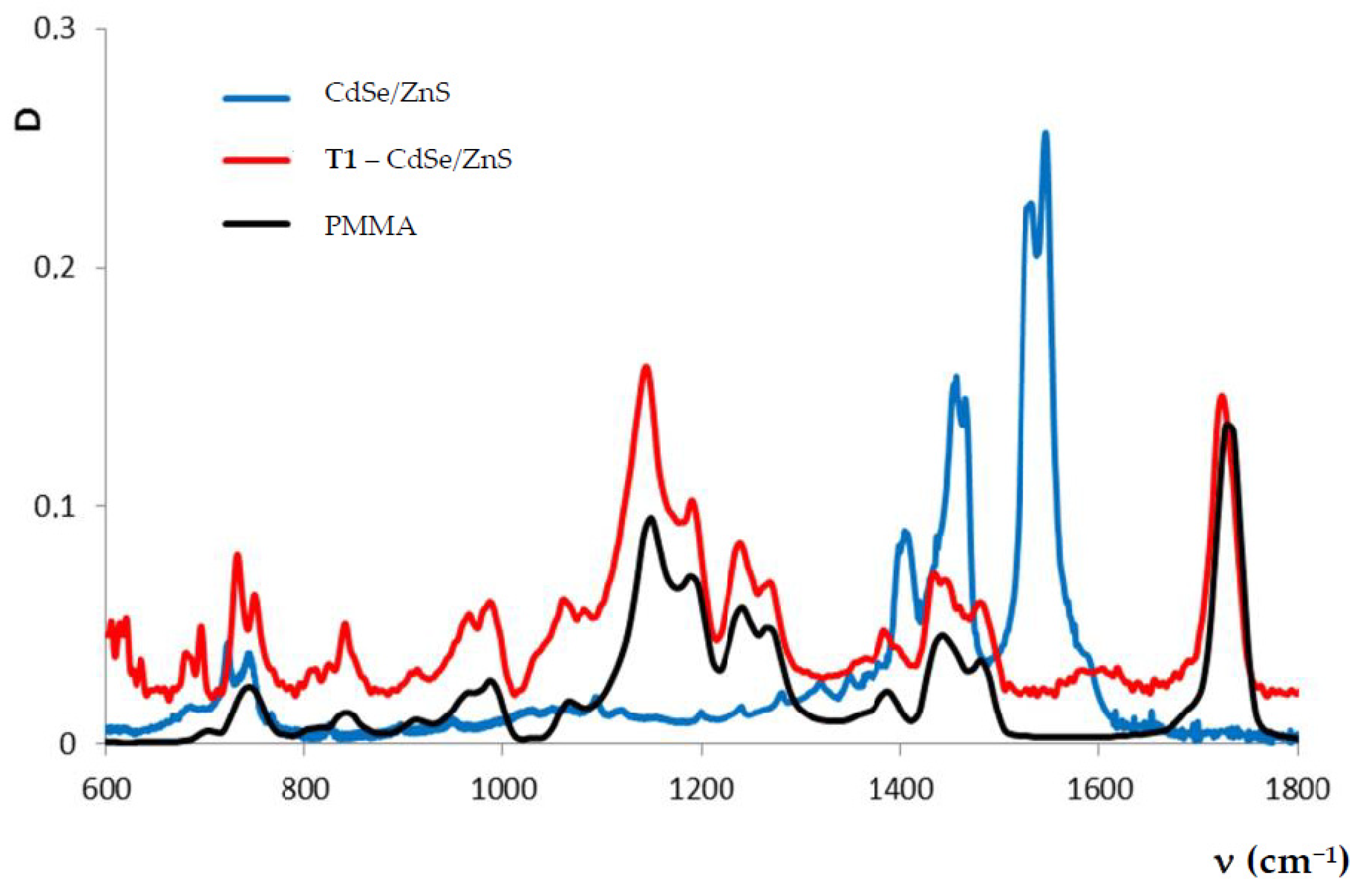

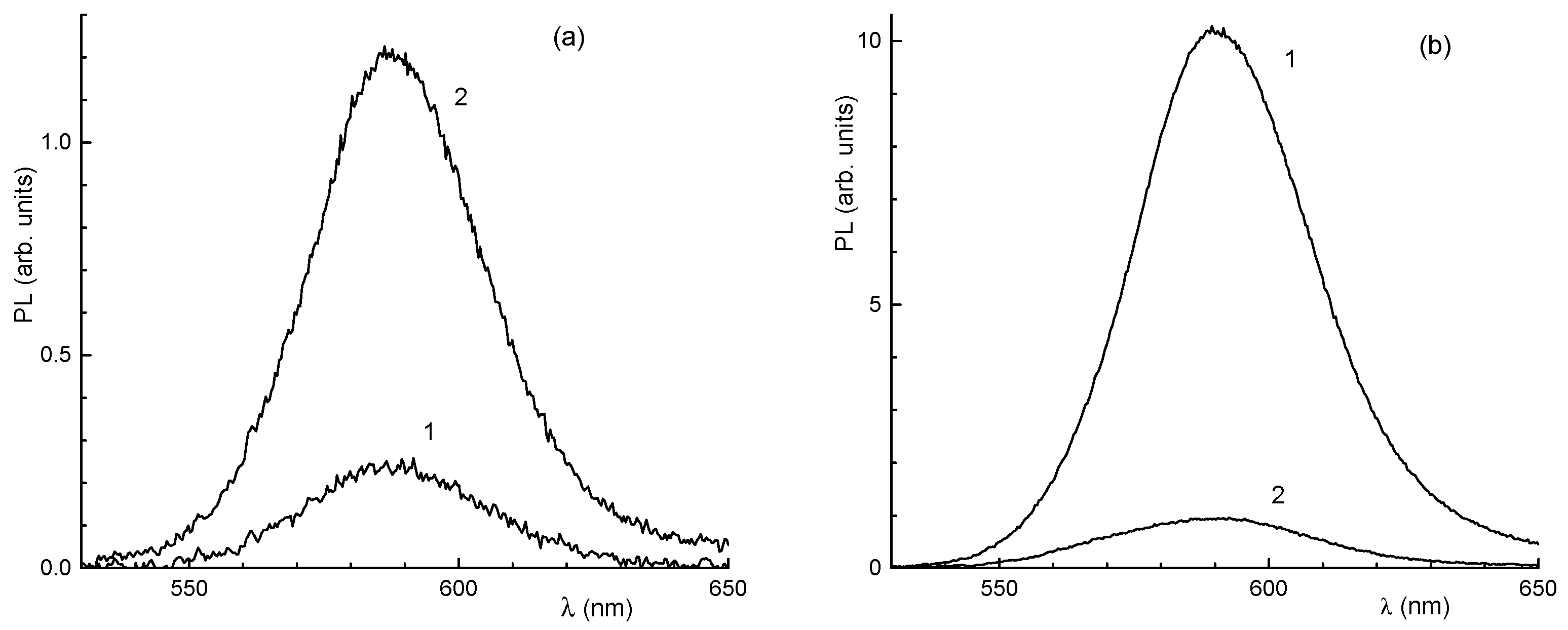
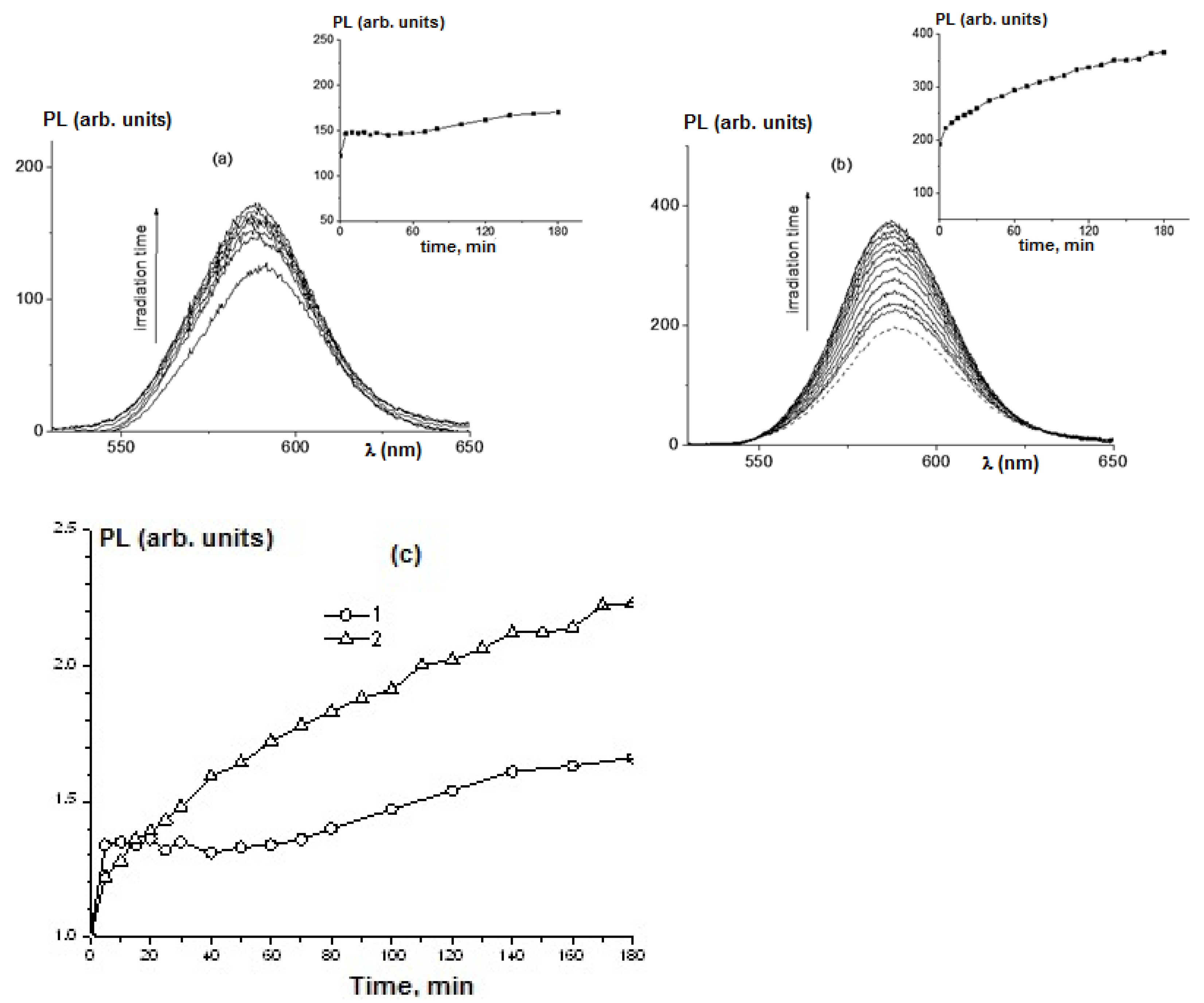



| QDs | Sample | Weight Fraction of QDs in Mixture, % | Weight Fraction of QDs in Nanocomposite, % |
|---|---|---|---|
| CdSe | M1—QDs | 1.4 | 0.39 |
| M2—QDs | 1.4 | 0.67 | |
| T1—QDs | 1.4 | 1.13 | |
| T2—QDs | 1.4 | 0.78 | |
| CdSe/ZnS | M1—QDs | 3.2 | 0.16 |
| M2—QDs | 3.2 | 0.22 | |
| T1—QDs | 3.2 | 1.12 | |
| T2—QDs | 3.2 | 0.86 |
| Sample | RAFT Agent, mol/L | AIBN, mol/L | Conversion, % | Mn, kDa (SEC) | Ð | Mn, kDa (UV) |
|---|---|---|---|---|---|---|
| PMMA1 | CPTPA, 7 × 10−2 | 1 × 10−3 | 33.4 | 9.6 | 1.11 | 10.0 |
| PMMA2 | CPTPA, 3.2 × 10−2 | 5 × 10−4 | 32.0 | 28.1 | 1.16 | 28.4 |
| PMMA3 | CPDTC, 3 × 10−2 | 5 × 10−4 | 55.1 | 7.7 | 1.23 | 8.0 |
| PMMA4 | CPDTC, 5 × 10−2 | 1 × 10−4 | 38.0 | 33.4 | 1.22 | 35.2 |
| Sample | End Functionality | RAFT Agent | Modification | Mn, kDa | Đ |
|---|---|---|---|---|---|
| T1 | SH and COOH | CPTPA | NaBH4 | 9.6 | 1.11 |
| T2 | SH and COOH | CPTPA | NaBH4 | 28.1 | 1.16 |
| M1 | SH | CPDTC | C2H5NH2 | 7.7 | 1.23 |
| M2 | SH | CPDTC | C2H5NH2 | 33.4 | 1.22 |
Publisher’s Note: MDPI stays neutral with regard to jurisdictional claims in published maps and institutional affiliations. |
© 2021 by the authors. Licensee MDPI, Basel, Switzerland. This article is an open access article distributed under the terms and conditions of the Creative Commons Attribution (CC BY) license (https://creativecommons.org/licenses/by/4.0/).
Share and Cite
Jablanovic, A.D.; Bekanova, M.Z.; Litmanovich, E.A.; Karpov, O.N.; Bugakov, M.A.; Shandryuk, G.A.; Ezhov, A.A.; Talroze, R.V.; Chernikova, E.V. Monochelic Versus Telechelic Poly(Methyl Methacrylate) as a Matrix for Photoluminescent Nanocomposites with Quantum Dots. Molecules 2021, 26, 4131. https://doi.org/10.3390/molecules26144131
Jablanovic AD, Bekanova MZ, Litmanovich EA, Karpov ON, Bugakov MA, Shandryuk GA, Ezhov AA, Talroze RV, Chernikova EV. Monochelic Versus Telechelic Poly(Methyl Methacrylate) as a Matrix for Photoluminescent Nanocomposites with Quantum Dots. Molecules. 2021; 26(14):4131. https://doi.org/10.3390/molecules26144131
Chicago/Turabian StyleJablanovic, Anastasija D., Marianna Z. Bekanova, Ekaterina A. Litmanovich, Oleg N. Karpov, Miron A. Bugakov, George A. Shandryuk, Alexander A. Ezhov, Raisa V. Talroze, and Elena V. Chernikova. 2021. "Monochelic Versus Telechelic Poly(Methyl Methacrylate) as a Matrix for Photoluminescent Nanocomposites with Quantum Dots" Molecules 26, no. 14: 4131. https://doi.org/10.3390/molecules26144131
APA StyleJablanovic, A. D., Bekanova, M. Z., Litmanovich, E. A., Karpov, O. N., Bugakov, M. A., Shandryuk, G. A., Ezhov, A. A., Talroze, R. V., & Chernikova, E. V. (2021). Monochelic Versus Telechelic Poly(Methyl Methacrylate) as a Matrix for Photoluminescent Nanocomposites with Quantum Dots. Molecules, 26(14), 4131. https://doi.org/10.3390/molecules26144131









